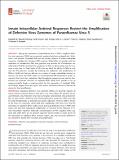Files in this item
Innate intracellular antiviral responses restrict the amplification of defective virus genomes of parainfluenza virus type 5
Item metadata
| dc.contributor.author | Wignall-Fleming, Elizabeth B | |
| dc.contributor.author | Vasou, Andri | |
| dc.contributor.author | Young, Dan | |
| dc.contributor.author | Short, John A L | |
| dc.contributor.author | Hughes, David J | |
| dc.contributor.author | Goodbourn, Steve | |
| dc.contributor.author | Randall, Richard E | |
| dc.date.accessioned | 2020-06-30T13:30:01Z | |
| dc.date.available | 2020-06-30T13:30:01Z | |
| dc.date.issued | 2020-06-16 | |
| dc.identifier | 267482669 | |
| dc.identifier | 15bc8fd9-b46b-4da9-a014-4d2a1f341461 | |
| dc.identifier | 32295916 | |
| dc.identifier | 85086683067 | |
| dc.identifier | 000550171000003 | |
| dc.identifier.citation | Wignall-Fleming , E B , Vasou , A , Young , D , Short , J A L , Hughes , D J , Goodbourn , S & Randall , R E 2020 , ' Innate intracellular antiviral responses restrict the amplification of defective virus genomes of parainfluenza virus type 5 ' , Journal of Virology , vol. 94 , no. 13 , 00246-20 . https://doi.org/10.1128/JVI.00246-20 | en |
| dc.identifier.issn | 0022-538X | |
| dc.identifier.other | ORCID: /0000-0002-9304-6678/work/72360228 | |
| dc.identifier.other | ORCID: /0000-0003-4051-4658/work/72360543 | |
| dc.identifier.other | ORCID: /0000-0002-0090-5710/work/72360794 | |
| dc.identifier.uri | https://hdl.handle.net/10023/20180 | |
| dc.description.abstract | During the replication of parainfluenza virus type 5 (PIV5) copyback defective virus genomes (DVGs) are erroneously produced and are packaged into "infectious" virus particles. Copyback DVGs are primary inducers of innate intracellular responses, including the interferon (IFN) response. Whilst DVGs can interfere with the replication of non-defective (ND) virus genomes and activate the IFN-induction cascade before ND PIV5 can block the production of IFN, we demonstrate that the converse is also true, i.e. high levels of ND virus can block the ability of DVGs to activate the IFN-induction cascade. By following the replication and amplification of DVGs in A549 cells that are deficient in a variety of innate intracellular antiviral responses, we show that DVGs induce an uncharacterised IFN-independent innate response(s) that limits their replication. High throughput sequencing was used to characterise the molecular structure of copyback DVGs. Whilst there appears to be no sequence-specific break or rejoining points for the generation of copyback DVGs, our finds suggest that there are region, size and/or structural preferences selected for during for their amplification. Importance Copyback defective virus genomes (DVGs) are powerful inducers of innate immune responses both in vitro and in vivo. They impact the outcome of natural infections, may help drive virus-host co-evolution, and promote virus persistence. Due to their potent interfering and immunostimulatory properties, DVGs may also be used therapeutically as antivirals and vaccine adjuvants. However, little is known of the host cell restrictions which limit their amplification. We show here that the generation of copyback DVGs readily occurs during parainfluenza virus type 5 (PIV5) replication but that their subsequent amplification is restricted by the induction of innate intracellular responses. Molecular characterisation of PIV5 copyback DVGs suggests that whilst there are no genome sequence specific breaks or rejoin points for the generation of copyback DVGs, genome region, size and structural preferences are selected for during their evolution and amplification. | |
| dc.format.extent | 15 | |
| dc.format.extent | 3321602 | |
| dc.language.iso | eng | |
| dc.relation.ispartof | Journal of Virology | en |
| dc.subject | Defective virus genomes | en |
| dc.subject | Host cell restriction | en |
| dc.subject | Innate immunity | en |
| dc.subject | Paramyxoviruses | en |
| dc.subject | QR355 Virology | en |
| dc.subject | RM Therapeutics. Pharmacology | en |
| dc.subject | T-NDAS | en |
| dc.subject | SDG 3 - Good Health and Well-being | en |
| dc.subject.lcc | QR355 | en |
| dc.subject.lcc | RM | en |
| dc.title | Innate intracellular antiviral responses restrict the amplification of defective virus genomes of parainfluenza virus type 5 | en |
| dc.type | Journal article | en |
| dc.contributor.institution | University of St Andrews. School of Biology | en |
| dc.contributor.institution | University of St Andrews. Biomedical Sciences Research Complex | en |
| dc.identifier.doi | 10.1128/JVI.00246-20 | |
| dc.description.status | Peer reviewed | en |
This item appears in the following Collection(s)
Items in the St Andrews Research Repository are protected by copyright, with all rights reserved, unless otherwise indicated.

